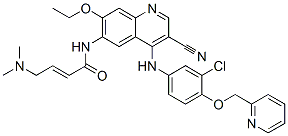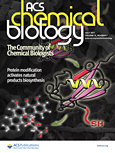All AbMole products are for research use only, cannot be used for human consumption.

Neratinib is a potent irreversible inhibitor of epidermal growth factor receptor and human epidermal receptor 2 with IC50 of 92 nM and 59 nM, respectively. Neratinib inhibits the proliferation of EGFR-dependent A431 cells with an IC50 of 81 nM. Neratinib (HKI-272) also weakly inhibits tyrosine kinases KDR and Src with IC50 of 0.8 μM and 1.4 μM, respectively. Likewise, Neratinib inhibited the photolabeling of ABCB1 with [(125)I]iodoarylazidoprazosin in a concentration-dependent manner (IC50 = 0.24 μM). Neratinib enhanced the sensitivity of ABCB1-overexpressing cells to ABCB1 substrates. It is noteworthy that Neratinib augmented the effect of chemotherapeutic agents in inhibiting the growth of ABCB1-overexpressing primary leukemia blasts and KBv200 cell xenografts in nude mice. Moreover, Neratinib increased doxorubicin accumulation in ABCB1-overexpressing cell lines and Rhodamine 123 accumulation in ABCB1-overexpressing cell lines and primary leukemia blasts. Neratinib (HKI-272) stimulated the ATPase activity of ABCB1 at low concentrations but inhibited it at high concentrations.

J Pharm Pharmacogn Res. 2025 Jan 14;13 (3), 919-924.
Extract of Holothuria scabra exhibits synergistic effect with chemotherapeutic agents against breast cancer in vitro
Neratinib purchased from AbMole

Cell Death Dis. 2021 Feb 15;12(2):179.
Targeting transcription of MCL-1 sensitizes HER2-amplified breast cancers to HER2 inhibitors
Neratinib purchased from AbMole

Int J Clin Exp Med. 2019 Aug 30;12(8):10373-10379.
Neratinib inhibits the malignant phenotype via inhibiting the HER2 in osteosarcoma cells
Neratinib purchased from AbMole

ACS Chem Biol. 2016 May 20;11(5):1245-54.
Chemical Proteomics Reveals Ferrochelatase as a Common Off-target of Kinase Inhibitors
Neratinib purchased from AbMole
| Cell Experiment | |
|---|---|
| Cell lines | 3T3, 3T3/neu, A431, SK-Br-3, BT474, MDA-MB-435, and SW62 cells |
| Preparation method | Cell Proliferation Assays. Cells were plated in 96-well tissue culture plates (3T3, 3T3/neu, 5000 cells/well; A431, SK-Br-3, BT474, MDA-MB-435, and SW620, 10,000 cells/well). The following day, dilutions of compound (0.5 ng/ml–5 μg/ml) were added, and cells were cultured for 2 days (6 days for BT474). Cell proliferation was determined using sulforhodamine B, a protein binding dye. Briefly, cells were fixed with 10% trichloroacetic acid and washed extensively with water. Cells were then stained with 0.1% sulforhodamine B (M11518) and washed in 5% acetic acid. Protein-associated dye was solubilized in 10 mm Tris, and absorbance was measured at 450 nm (Victor2). Inhibition of cell proliferation was calculated using the formula: percentage of inhibition = 100 − 100 (Td − To/Tc − To), where Td is the absorbance of drug treated cells, Tc is the absorbance of untreated cells, and To is the absorbance at the time of drug addition. To values were determined by plating cells separately and fixing them at the time of drug addition. The concentration of compound which inhibits cell proliferation by 50% (IC50) was determined from inhibition curves. |
| Concentrations | 0.5 ng/ml-5 μg/ml |
| Incubation time | 2 days |
| Animal Experiment | |
|---|---|
| Animal models | BT474, MCF-7, and SK-OV-3 tumour xenografts model in female athymic (nude) mice |
| Formulation | 0.5% methocellulose-0.4% polysorbate-80 (Tween 80) |
| Dosages | 40 or 60mg/kg daily for 20 days |
| Administration | oral gavage |
| Molecular Weight | 557.04 |
| Formula | C30H29ClN6O3 |
| CAS Number | 698387-09-6 |
| Solubility (25°C) | DMSO 8 mg/mL |
| Storage |
Powder -20°C 3 years ; 4°C 2 years In solvent -80°C 6 months ; -20°C 1 month |
| Related EGFR/HER2 Products |
|---|
| Depatuxizumab
Depatuxizumab is a brain-penetrant and humanized tumor-specific anti EGFR monoclonal antibody. Depatuxizumab inhibits the growth of xenograft models of mutant EGFRvIII and wild-type EGFR. |
| Sevabertinib
Sevabertinib is an epidermal growth factor receptor (EGFR) tyrosine kinase inhibitor with antitumor activity. |
| BPIQ-I
BPIQ-I (PD 159121) is a potent and ATP-competitive EGFR tyrosine kinase inhibitor.. |
| HKI-357
HKI-357 is an irreversible dual inhibitor of EGFR and ERBB2 with IC50s of 34 nM and 33 nM, respectively. |
| SJF-1528
SJF-1528 is a potent EGFR PROTAC degrader with DC50 values of 39.2 nM and 736.2 nM for wild-type EGFR in OVCAR8 cells and Exon 20 Ins mutated EGFR in HeLa cells. |
All AbMole products are for research use only, cannot be used for human consumption or veterinary use. We do not provide products or services to individuals. Please comply with the intended use and do not use AbMole products for any other purpose.


Products are for research use only. Not for human use. We do not sell to patients.
© Copyright 2010-2024 AbMole BioScience. All Rights Reserved.
